The Puerco Mountains Report #1
My name is Roger Repp, and my friends call me Moody. My friend is Dr. Gordon Schuett, but I call him Broody. We are Moody and Broody, two Americans of Germanic descent linked together by a common obsession-Herpetology.
I'm a Machine Shop Foreman-I have a Ph.D. in college avoidance. Broody has all sorts of alphabet soup after his name-more degrees than your average thermometer. But he hides his lobotomy scars well. We are a mismatch of sorts: a died-in-the-wool herp phud academic working side-by-side with a testy, cretin shop foreman. We bicker often, but our common interest holds it all together.
Just to give you some idea of what we look like, in profile I pretty much look like a pregnant strand of vertically stretched barbed wire. Broody looks like a brick standing upright, covered with fur--with just a little brick showing up top. Why are hairy guys so often bald?
While we both keep snakes, that is not our passion. Snakes behind glass is not what we're about. We keep the majority of our snakes in an aquarium the size of planet Earth.
This would be a good place to acknowledge our friends, Dave and Tracy Barker. While they are world famous for the work they have done with snakes behind glass, their hearts are in the field. For some time, I have been sending Dave reports of great deeds by the herps under my watch in the Sonoran Desert near Tucson, Arizona. Since Dave is a full packaged Herpetologist himself, he saw a chance for the Herpetoculturists who often visit his VPI website to see reptiles in a different light. It is our sincere hope that here at VPI.com we can introduce the visitors to this website to a whole different aspect of Herpetology.
Namely, the world of rattlesnakes, Gila Monsters and other herps as they exist in a pristine stretch of Sonoran Desert.
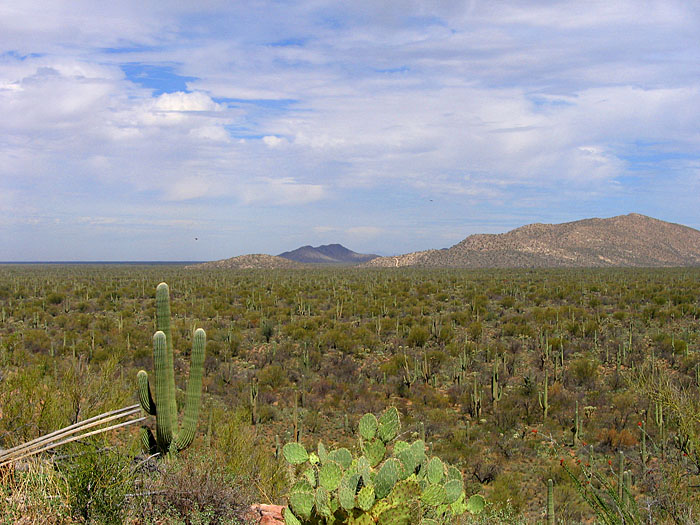 Puerco MountainsIt's time for the first picture. What you are looking at is the Puerco Mountains. They are located roughly one hour out of Tucson, in one direction or another, depending on which direction you arrive from. (Grin) In other words, we aren't telling you where they're at. And if you ever find the place--please keep going. There are many places in Arizona that will give you more of what you are probably seeking.
Puerco MountainsIt's time for the first picture. What you are looking at is the Puerco Mountains. They are located roughly one hour out of Tucson, in one direction or another, depending on which direction you arrive from. (Grin) In other words, we aren't telling you where they're at. And if you ever find the place--please keep going. There are many places in Arizona that will give you more of what you are probably seeking.
Western diamondback rattlesnakes (Crotalus atrox) rule the Puerco Mountains. They are the only common snake species to occur there. Behind glass, many keepers consider them to be only common. But here, on their ground, they are priceless. Other ophidian species that occur here appear only rarely, and none of these have any value in the herp marketplace.
Gila Monsters can be found here as well--but they are scarcer than a virgin in a maternity ward. In 15 years of searching, only 12 different individuals have been encountered. In other places, that many could be found in a week! Desert tortoises (Gopherus agassizii) are fairly common here, but in Arizona, they are a protected species.
Now remember, we are asking our readers to just stay away. Let me tell you about what happens here in the Puercos. The real value of the community of reptiles living in the Puercos to all of us is on the ground that they occupy. They are doing incredible things. We are documenting these incredible things, and we are passing them on to you for knowledge sake.
Moody's first penetration of the Puercos was in 1992. Tortoises and western lyre snakes (Trimorphodon biscutatus) were the first species of note to be encountered. It wasn't until 1999 that the first atrox den was encountered, and it was also 1999 that the first Gila monster was found.
In March 2001, I joined forces with Moody to do a radio telemetry project with atrox. Radio telemetry involves surgically implanting a small transmitting device inside the animal's body. The transmitter then gives off a series of beeps that, utilizing a receiver and antenna, allow us to track them to within roughly a square foot of ground that they are on or under. The range of these transmitters varies based upon size, but if there is some high ground available, we can reach out about one mile to get a signal on any given animal. As if this hasn't already gotten complicated enough, the transmitters beep fast if they are warm, and slow if they are cold, to a very accurate
(+/- 1 degree C) gradient. Hence, by using graphs that are unique to each individual transmitter, we can accurately determine the animal's body temperature.
The original plan was to surgically implant transmitters into atrox only. Then some black-tailed rattlesnakes (Crotalus molossus) and Gila Monsters (Heloderma suspectum) showed up, so we added them to the game. By the end of 2001, we had electronic junk implanted in 0.3 female atrox, 1.1 molossus, and 1.1 Gila monsters.
The biggest initial surprise was the amount of ground the Gilas covered. We learned that a kilometer movement in a few days is nothing to them. We had nights where we would track them to one location, and the following morning, they would be out of signal range from that particular location. At the opposite end of the spectrum is their ability to move into/under a site, and remain buried for up to five months without moving a muscle. At times, they are like tracking Russian nuclear submarines! They can stay down a LONG time.
By mid-2003, we were tracking 7 Gila monsters, and 25 atrox. Our almighty number of specimens under observation ("N") has always varied based on scientific whim and available resources. As of the date of this writing, we are eliminating Gila monsters, adding tiger rattlesnakes (Crotalus tigris), and ready to kick things up a notch in directions too numerous to go into at this point in time. I'll tell you as we go along. As we enter our seventh year of watching Mother Nature cautiously lift her skirt for us, we have many questions that need to be addressed with scientific approach.
The best way to end this first of what may be a short lived series of reports is to show some photos of that which he have seen thus far. The next report--and all that follow, will deal with what is happening NOW! We hope that any readers of this first report will come along for the ride.
*******************
19 September 2005
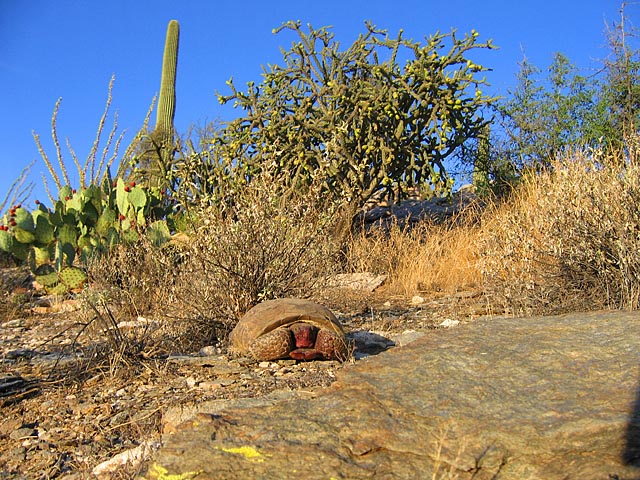 Desert TortoiseA desert tortoise (Gopherus agassizii) out cruising the lower slopes of a hillside. Note that the face, forelimbs, and gular are stained red--obviously from feasting on prickly pear fruit. Also note the prickly pear cactus in the upper left background of the photo.
Desert TortoiseA desert tortoise (Gopherus agassizii) out cruising the lower slopes of a hillside. Note that the face, forelimbs, and gular are stained red--obviously from feasting on prickly pear fruit. Also note the prickly pear cactus in the upper left background of the photo.
12 August 2006
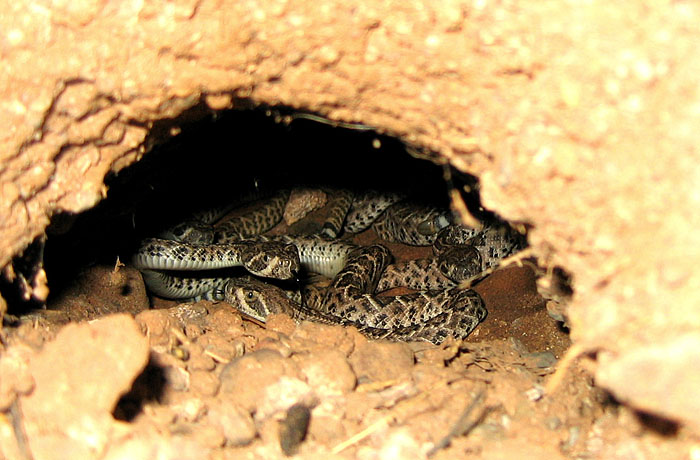 Newborn DiamondbacksSix neonate western diamondback rattlesnakes (Crotalus atrox) in their nest hole. These are the offspring of one of our radio-telemetered subjects. The nesting habits of atrox are normally difficult to photo. It took over six years and 30 nests to score this photo opportunity.
Newborn DiamondbacksSix neonate western diamondback rattlesnakes (Crotalus atrox) in their nest hole. These are the offspring of one of our radio-telemetered subjects. The nesting habits of atrox are normally difficult to photo. It took over six years and 30 nests to score this photo opportunity.
9 September 2006
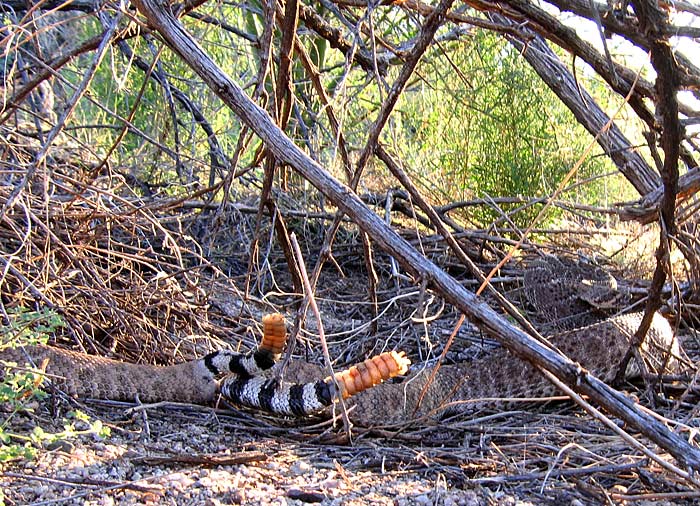 Atrox MatingMating pair of Crotalus atrox. The female is to the left, her identity remains unknown. The male is a radio-telemetered subject.
Atrox MatingMating pair of Crotalus atrox. The female is to the left, her identity remains unknown. The male is a radio-telemetered subject.
20 January 2007
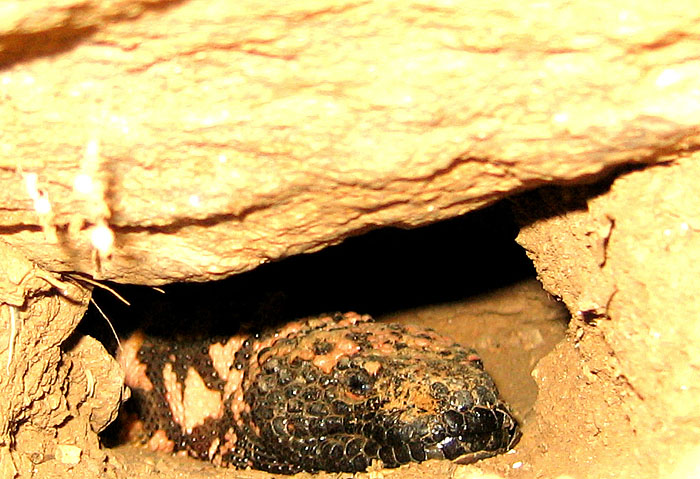 Gila MonsterGila monster (Heloderma suspectum) in its hibernacula. As is often the case in Arizona, this Gila Monster was visible in its lair throughout the winter of 2006/2007.
Gila MonsterGila monster (Heloderma suspectum) in its hibernacula. As is often the case in Arizona, this Gila Monster was visible in its lair throughout the winter of 2006/2007.
********************
We hope our readers will tune in to the May 2007 Puerco Mountain Report.
It promises to be full of fun, finds, and flandickery.
Best to all, Moody and Broody
